El Viajero
Former Carmelite convent converted into...
Antiguo convento carmelita reconvertido...
Antiguo convento carmelita reconvertido en molino de aceite. Se halla frente a la parroquia de Santa María Magdalena, en la parte izquierda de la población, junto al río como es lógico esperar de un molino. Suele haber sitio para aparcar delante, en último extremo en la parte trasera de la iglesia siempre hay aparcamiento.
El convento carmelita se construyó a mediados del siglo XVIII. Las partes esenciales de su estructura se mantienen, a pesar de las constantes remodelaciones que ha padecido. Tras el portón de entrada se accede a un patio de grandes dimensiones con una serie de dependencias comunes. Accediendo a la parte más profunda del convento se llega a un pequeño y típico claustro con las celdas, el refectorio y la cocina. En un lateral de la fachada la torre de la antigua capilla conventual.
Tras la desamortización fue utilizado como molino de aceite, restaurándose recientemente para su uso etnográfico. De ahí que el gran patio tenga funcionalidad de molino sirviendo de museo al aire libre. No hay que fiarse de la fecha que consta en la portada porque no corresponde a su construcción sino al año en que se remodeló la fachada dándole la fisonomía actual. Fue en ese año cuando se situó el azulejo de la Virgen de Guía que preside la entrada.
Former Carmelite convent converted into oil mill. It is opposite the parish of St. María Magdalena, on the left side of the people, by the river as it is logical to expect a mill. There is usually a place to park in front, ultimately at the back of the church there is always parking. The Carmelite convent was built in the mid eighteenth century. The essential parts of the structure are maintained, despite the constant remodeling that has suffered. After the gateway is accessed patio large a number of common areas. He accessing the deepest part of the convent reach a typical small cloister with the cells, the refectory and the kitchen. On one side of the facade the tower of the former convent chapel. After the confiscation was used as oil mill, recently being restored to its ethnographic use. Hence the large patio has functionality mill serving as open-air museum. Do not rely on the date stated on the cover because not for construction but the year in which the facade was redesigned giving the current appearance. It was in that year when the tile Virgen Guide presiding over the entrance stood.



+3

